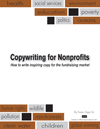Today I share some highlights from a terrific study by Russ Reid Company, Heart of the Donor. They unveiled the results of their 2010 study during the DMANF Conference in New York in August. The report will be available soon.
I was taking notes fast and furious as Lisa McIntyre (Senior VP of Strategy Development, Russ Reid Company) spoke. Here are some of the highlights I captured:
Parental involvement trumps any other activity in terms of WHY and whether people give to a charity. These six parental behaviors – and how many of them your parents did – have the greatest influence on your behavior toward charities:
– Gave money to their place of worship
– Gave money to other charities
– Talked about nonprofit organization in front of children and why they gave
– Take children to place of worship
– Parents volunteer for a nonprofit
– Parents take the child along to also volunteer
As I understand it, 80% of the children from parents with this behavior become donors. And the more parents exhibited this behavior . . . the more generous the kids are when they grow up and start to give.
If donors are under the age of 40 . . . they’re seeking to get an “impression” about you through social media, talking to friends, and visiting your website.
If donors are over the age of 40 . . . they’re checking for information about you; checking your credibility; they read the annual report and look at your overhead; and they check your website.
People over the age of 70 are still among the most valuable donors – most generous and most loyal. Focus most of your resources on the donors giving you the greatest value.
NO CHANNEL stands alone. On average, donors use 3 out of 10 channels listed to give:
64% – collection box
61% – mail
34% – online
29% – workplace
26% – place of worship
22% – telemarketing
18% – TV/radio
15% – automatic (auto-pay / sustainer)
14% – gift catalog
8% – text (mobile)
Website is your single most important communication vehicle at your disposal. When people investigate charities . . .
62% go to the charity website
56% search the web
46% talk to a friend that already supports you
44% check your overhead
etc.
What do they want to find on your website, in your letters, everywhere? What factors have the greatest influence on whether you receive that first gift?
– Is there evidence you do what you claim?
– How do you do it?
– What have you done so far?
– How much do you spend on overhead?
If you want an illustration related to that last set of bullets, this post will help you see what you need to change on your website: Cartoon Shows Disconnect in Nonprofit Websites
What donors want more than anything is VALUE. And if you need to spend more on salaries to do it right and provide value . . . that’s okay. And if it means you need to spend more on fundraising to give value and do a good job of helping others . . . that’s okay. Lesson here is that IF you provide value (as perceived by donors), and you communicate that value CLEARLY, they won’t criticize you for spending more money wisely.
If you want to become a donor’s favorite charity you must accomplish three things: First and foremost you must be trustworthy. And your mission must be relevant to the donor personally and through any experience they have with you. Trust coupled with how relevant you are to them personally, and their experience with you all leads to a very loyal donor.
I recommend you get this study when it’s published. It correlated exceedingly well with a study by Convio also shared during the conference. I think that says a lot for how safely you can take this data and apply it to your nonprofit.

{ 2 trackbacks }
{ 0 comments… add one now }